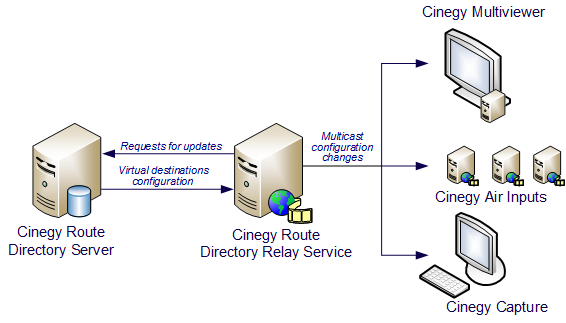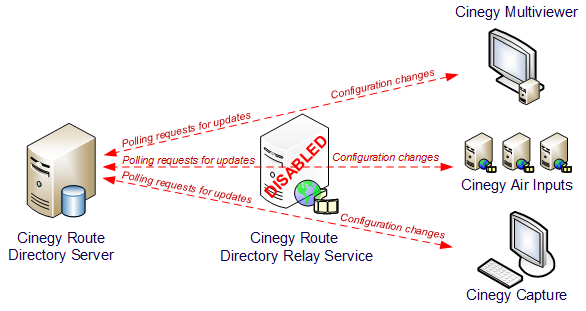Overview
Reading time ~2 minutes
The Cinegy Route Directory Service is quick and easy to set up, and works well in small to medium-size environments. Once the number of connected clients increases or the network topology becomes more complex, the polling request model becomes limited.
To address this, Cinegy Route comes with the Cinegy Route Directory Relay Service, a dedicated service for tracking changes on the central Cinegy Route Directory Service and notifying the broadcast clients about them over multicast, reducing network load and the load on the core Cinegy Route service.
Using the Cinegy Route Directory Relay Service is an advanced option. It requires the installation engineer to have skills in network configuration, multicast adjustment and routing, as well as packet inspection to verify correct operations and perform any multicast troubleshooting.
The Cinegy Route Directory Relay Service tracks changes on the Cinegy Route Directory Service and sends them to the signal receivers.
The following diagram shows the general channel relay workflow, in normal operation:

As shown above, the Cinegy Route Directory Relay Service sends requests to the Cinegy Route Directory Service for information about changes in the physical sources and virtual destinations configuration. If any changes are found, they are sent to the network as a multicast data stream, which any broadcast clients discover by checking a fixed multicast address for changes that are applicable to them. Then clients adjust to the change with no communication to the Cinegy Route Directory Service required.
When the relay multicast messages are not received by a client for more than 10 seconds, for example, because of connection loss or the service being stopped, the client will try to directly connect to the main Cinegy Route Directory Service. In case of failure to connect, the last known configuration is retained until messages are recovered. The following diagram shows this configuration model:

|
Note
|
With a great number of RTP/UDP/SRT streams, this configuration can cause network overload. |